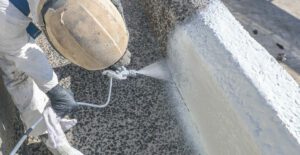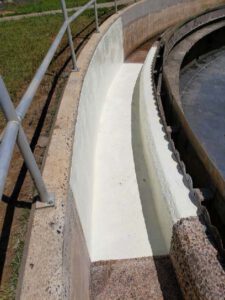With a rated treatment capacity of 64 million gallons a day (MGD), the McAlpine Creek Wastewater Management Facility is the largest wastewater treatment facility operated by Charlotte Water (CLTWater). In 2018, CLTWater began a reliability and process improvements project that is being implemented via the progressive design-build project delivery method and involves the rehabilitation of 28 aeration basins and 16 secondary clarifiers and the replacement of the plant’s three blower buildings. The secondary clarifiers range from 95 to 150 feet in diameter, with the oldest clarifiers being nearly 60 years old.
For the rehabilitation, CLTWater considered using an epoxy coating system to not only protect the assets but to extend the clarifier’s service life. CLTWater had experience with epoxy coatings and understood the importance of protecting its investment. However, it had historically run into issues with failures and delamination throughout its collection system. Due to this, CLTWater opted to move forward with a pilot study with four different epoxy manufacturers. Three of the four manufacturers applied a test patch of their epoxy within the clarifier launder troughs, and a third-party testing firm performed adhesion tests. All three met the minimum adhesion requirements.

In addition to performing adhesion tests, CLTWater and its design-build team analyzed each manufacturer’s coating system along a variety of variables, including cost, schedule, performance, quality, service life, and safety. The analysis provided them the information necessary to make a value-based selection. Warren Environmental’s 301 epoxy system was determined to provide the best value for the project.
Warren Environmental’s epoxy was not the cheapest of the four options, but because it does not require a mortar underlayment and is applied in only a single coat, it stood to save CLTWater 7 months of time, and thus saved the most money overall. If CLTWater had decided to use a different product, the minimum cure time required by the product’s
mortar underlayment might have delayed the project as a whole and resulted in additional overhead costs.
Of the systems included in the pilot, Warren Environmental’s 100 percent solids epoxy system was the only one capable of being easily sprayed in a single coat up to 500 mils (½ inch) thick. That coat fully covered the concrete aggregate and protected the asset. It was also able to provide for a return to service within 4–6 hours. The fact that Warren’s product only required a single coat assured CLTWater that quality across all 16 clarifiers would remain consistent and that the product would not lead to failures or the delamination it has experienced in the past.
Another key benefit of the Warren epoxy coating was its safety. All its epoxies are free of volatile organic compounds, solvents, styrene, and isocyanates, making the product safe for applicators, workers, and the surrounding work site. This provided tremendous benefit to CLTWater in terms of craft resource allocation. Warren Environmental’s master applicator, A&W Maintenance, recently completed the first phase of the project and discussed the benefits of this attribute. “One of the benefits clients are drawn to Warren for is safety. We worked alongside other technicians who were building rake arms as we sprayed our epoxy, and it was a seamless transition of work. They didn’t need to worry about us, and we didn’t have to worry about them. That speaks to the safety of the Warren product. There are not many coatings out there that allow you to work side by side with another contractor and achieve your goals,” said Max Silva, the project manager for A&W Maintenance. Originally, CLTWater’s project schedule provided for the reallocation of workers to another area during epoxy spraying to avoid any potential hazards, but because of Warren’s safety attributes, it was able to be done concurrently with the rest of the project.

The first phase of the project, which consisted of coating clarifier launder troughs #11 and #13, was completed at the end of November 2019. This required the rehabilitation of 60‑year old concrete. The rehabilitation involved prepping the substrate’s surface and cleaning it of all debris. The surface showed depths of up to ½ inch of exposed aggregate. Applicators then sprayed a single coat of approximately 125 mils of Warren’s 301‑14 epoxy at a rate of five shifts per clarifier. Upon completion, the quality of work was inspected. The applicators performed holiday tests with a high-voltage spark tester to identify any pinhole defects requiring repair. Then, applicators conducted an adhesion pull test to verify the thickness of the coating. Each clarifier underwent five different pull tests. The average results for clarifier #11 was 1,014 pounds per square inch and the average result for clarifier #13 was 1,089 psi.
The effectiveness of Warren’s product and the quality installation by A&W Maintenance earned the two companies significant additional work. Warren’s epoxy products and A&W Maintenance’s application services were selected for work on 11 additional effluent troughs, the aluminum support columns at all 28 aeration basin mixer walkways, the pedestal coating at the gravity thickener, and crack injection and crack and construction joint sealing on an as-needed basis for all structures. The work is expected to be finished by the end of 2022.
Brian Brandstetter is the vice president of Warren Environmental. For more about Warren Environmental, visit warrenenviro.com.
